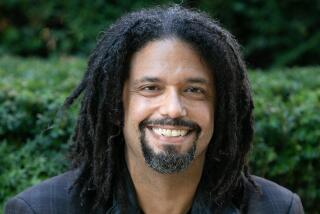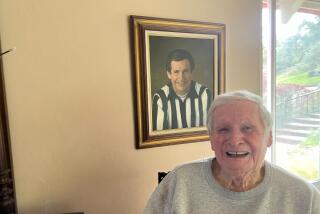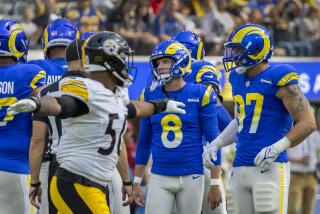Holding the Line : Lamar Lundy, a Member of Fearsome Foursome, Has Battled Neuro-Muscular Disease for 19 Years
Lamar Lundy could not open his eyes to see or move his mouth to speak. He could barely breathe and was aware of the presence of his former teammates only because of the boom of their voices around his hospital bed.
Merlin Olsen. Deacon Jones. And, intently leaning over Lundy’s face, Rosey Grier. They were there, watching over their friend, the fourth member of the Rams’ “Fearsome Foursome” defensive line that dominated the NFL in the mid-’60s. They were there, and they did not know what to think.
“Lamar Lundy was at death’s door,” Jones says now, 19 years later.
The Fearsome Foursome was bigger than life, but, until then, had never been faced with death.
Then, all of a sudden, Lundy felt a splash of water on his face. It was frightening. Lamar Lundy, 36 years old, 6 feet 7 and severely weakened by myasthenia gravis, forgot everything at that moment except his fight to stay alive.
And it was Grier’s drop of sweat that triggered Lundy’s fear.
“When that drop fell on me, I thought that maybe there was a leak in the ceiling,” Lundy says now. “I couldn’t talk, but I could spell with one of my fingers.
“When everybody realized what was going on and what had happened, that was a moment of laughter and probably a time when everybody could vent the stress that was there because of my condition,” Lundy says. “We all got a chance to laugh.
“I remember that was probably the first real laugh I had within myself. I remember that incident quite well.”
And the Fearsome Foursome was able to relax, because Lundy, who his teammates say was the soft-spoken glue that held those Ram teams tight, was laughing, not dying.
And 19 years later, Lundy is continuing to battle MG, a neuro-muscular disease that weakens all parts of the body, including the immune system. But now, at 55, with a strong upper hand on the disease after constant treatment, he still cannot help but laugh at that story.
The Fearsome Foursome was something special to him then, and the bonds are only tighter now as he comes back to town from his home in Richmond, Ind., to symbolically accept a check from Ram owner Georgia Frontiere Saturday night at a Myasthenia Gravis Foundation dinner at the Beverly Wilshire Hotel that will officially open the Lamar Lundy Medical Research Fund.
From 1963-66, the Fearsome Foursome was the NFL’s dominant defensive line--Jones at left end, Olsen at left tackle, Grier at right tackle and Lundy at right end.
Lundy first suffered symptoms of the disease after having been traded to the San Diego Chargers in 1970. His condition was diagnosed a year later. He can get around now fairly well on his own, but he cannot drive and “bad days” crop up too often for him to hold a regular job.
“I truly believe in my heart that he’s probably one of the few athletes who could have gone through what he had to go through,” Jones says. “When you’re coming off a good career and have a good coaching career ahead of you, everything is looking up and all of a sudden you get knocked down by MG, it can knock the wind out of anybody’s sails.”
Lundy says he faced his situation the same way he faced every other obstacle in his path, from racism in his home state of Indiana to constant battles with injuries to whatever befell him.
Except for the moment in 1972 when he dropped into “crisis,” what MG sufferers call a total collapse that prevents breathing, Lundy says he never despaired. Now, after continuous improvement, he looks back without pain.
“There were a lot of rough times and everything, but I think because of the way I was raised, there was always a challenge,” Lundy says. “And if I had said, ‘Why me?’ when I had to stand on the back of the bus, the why me’s just run out pretty soon.
“Except when this myasthenia gravis comes on, I was ‘Why me?’ there for a moment because it was such a drastic change from being able to do things for myself and being out on a football field to all of sudden eight months later I’m in front of group of doctors deciding how to keep me going. Yeah, there was a ‘Why me?’ at that time.
“There was a lot of fear, and not a lot of assurance to what the outcome was going to be because I hadn’t traveled that path before, even with all the injuries I had suffered in sports.”
The path Lundy had taken in sports was that of a statesman in a time of social discontent, a calm, respected voice in a locker room often edged with rage.
Lundy was a four-year veteran in 1961 when the Rams drafted Deacon Jones from South Carolina State and the segregated South, and soon enough Jones was Lundy’s roommate.
“Yeah, they were definitely the mismatched couple,” says Dick Bass, a running back with the Rams at the time.
At one point in his rookie season, Jones had a bad first half and was blistered in the locker room by then Coach Bob Waterfield. And if it had not been for Lundy’s intervention, Jones says now, he would have quit the game and probably ended his professional career.
“I was not only upset but completely misdirected,” Jones says. “It wasn’t easy for me at that time to take a tongue-lashing from a white person. Lamar was right there as soon as Waterfield stopped cutting me. He was right there with coolness and calmness.
“If it had not been for him, I would have probably been out of it right there. . . . I had one hell of a second half.
“He makes you like him, because you can see the honesty. You don’t have to wait for it. He was the chief honcho. Lamar Lundy.”
That’s why Jones and the others were there when Lundy was at his weakest. That’s why Jones and a number of his former teammates have consistently worked to provide Lundy with the money he needs for his treatment.
He never asked for the help, but he provided it when he was playing, which is why they are giving it to him now.
Says Bass: “Any time you’re a giving person and here’s Lamar facing all that he’s facing and he maintains that sense of humor and that intelligent outlook, and now’s a chance for us to really say thank you, all of us want to do that. The reaction (to the fund) has just been great. But I could have told you it would be great just because it was Lamar.”
Because it was Lundy who acted as the buffer between angry black players and the front office. Because it was Lundy who carved out the foundation of the Fearsome Foursome and never complained when the attention shifted to Olsen or Jones. Because in a time of trouble, Lundy stayed calm.
Was Lundy ever angry?
“I was, but it was controlled,” Lundy says. “You learned to control it.
“I just think coming up through the Indiana school system, I had learned how to bend and take to the segregated situation, because . . . even at Purdue, I was the first black there, it was a fact of already learning how to make adjustments and absorb it.”
The Fearsome Foursome has absorbed a lot in life, but it has not shattered.
“It’s kind of amazing we were only probably together for three years, but in those three years we developed something that’s lasting,” Lundy says.
More than 20 years ago, Lamar Lundy was the quiet man who set down the law in the Ram locker room, the leader his teammates looked to.
And, today, living his way through an insidious disease, he binds them still.


